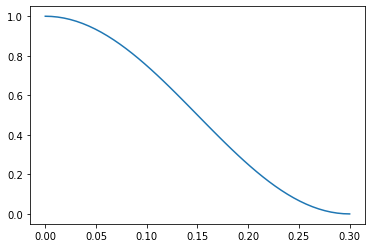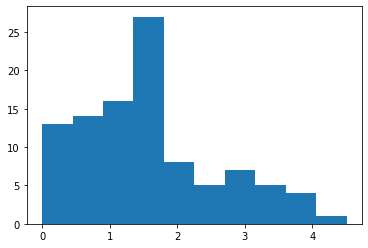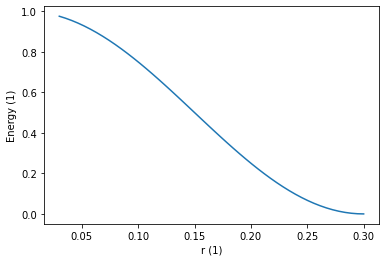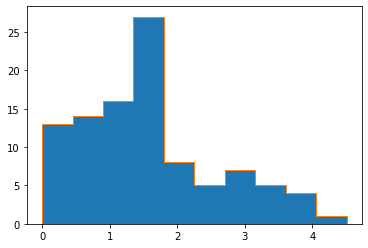Computing descriptors¶
Computing descriptors is an important part of both constructing datasets and using neural-network fits.
The problem¶
Consider a unit box in 3 dimensions. n = 100 atoms are present in the box;
their cartesian coordinates are written in a [100 x 3] matrix r such
that 0 <= r <= 1.
import numpy as np
n = 100
a = 0.3
r = np.random.rand(100, 3)
Our task is to count atomic neighbors inside a shell of size a = 0.3 for
each atom. This is what a typical descriptor looks like: it counts neighbors
in shells around each atom.
To make a continuous function out of neighbor count let’s introduce a kernel
function of neighbor distance r smoothly decaying from a unit value at
r = 0 down to zero at cutoff value r = a. Let’s take a half-period of
cosine function for this example.
def g(r):
return (1 + np.cos(np.pi * r / a)) / 2 * (r < a)
from matplotlib import pyplot
x = np.linspace(0, a)
pyplot.plot(x, g(x))
[<matplotlib.lines.Line2D at 0x7fc0cd9424d0>]

Instead of computing neighbors directly let’s compute the cumulative value of the kernel function for all neighbors.
Computing naively¶
We start with computing all pair distances between atoms.
mdist = np.linalg.norm(r[:, None, :] - r[None, :, :], axis=-1)
Then, we reduce pair distances using the kernel function.
result = g(mdist).sum(axis=0) - 1
Finally, we can plot the distribution of neighbors across all points.
from matplotlib import pyplot
pyplot.hist(result)
(array([13., 14., 16., 27., 8., 5., 7., 5., 4., 1.]),
array([0. , 0.45074515, 0.90149029, 1.35223544, 1.80298058,
2.25372573, 2.70447087, 3.15521602, 3.60596116, 4.05670631,
4.50745146]),
<BarContainer object of 10 artists>)

This approach is straightforward but not efficient. First, matrix mdist
includes information about very distant atoms we simply discard. Second, we can
only perform pair reductions this way: counting atomic triples within the same
sphere of radius a will require a tensor with three dimensions raising memory
requirements by a factor of n = 100. Instead, miniff uses a more efficient
approach with a quasi-linear complexity scaling.
Computing neighbors with miniff¶
miniff provides an interface to computing neighbors efficiently. It uses
KDTree from scipy to compute neighbor lists and cython functions
to iterate over the list and to reduce it to the desired quantities. As such,
there are two key steps.
1. Compute neighbor lists¶
The primary purpose of miniff.kernel module is to perform neighbor list
construction using compute_images method and CellImages class.
To do it, we first construct a unit cell object with atomic coordinates.
from miniff.kernel import Cell, compute_images
cell = Cell(np.eye(3), r, ['a'] * len(r))
The second step is to compute its images (neighbors) given the cutoff value and other periodicity information.
images = compute_images(cell, cutoff=a, pbc=False)
print(len(images.distances.data))
794
As a result, images.distances contains neighbor distance data.
2. Reduce¶
In principle, neighbor counts can be deduced from the sparse matrix
images.distances directly with previously defined method g.
A more conventional workflow is to pick a reduction function from
miniff.potentials module. Specifically,
miniff.potentials.sigmoid_descriptor_family provides the following reduction
function:
where r_ij is the distance matrix, r0, dr and a are constant
parameters. By setting dr to a small value and r0 to 2a we simplify
the expression to the second term only
resembling the kernel above. To instantiate the descriptor we simply call the factory object the specified parameters.
from miniff.potentials import sigmoid_descriptor_family
descriptor = sigmoid_descriptor_family(r0=10 * a, dr=a / 10, a=a)
Let’s visualise the radial form of the descriptor.
from miniff.presentation import plot_potential_2
plot_potential_2(descriptor, energy_unit="1", length_unit="1")
<AxesSubplot:xlabel='r (1)', ylabel='Energy (1)'>

To perform the reduction we simply feed the descriptor to images.eval.
result_miniff = images.eval(descriptor.copy(tag="a-a"), "kernel")
Not that descriptor.copy(tag="a-a") makes a copy of the descriptor with
the descriptor.tag = "a-a". The tag is required by images.eval
to distinguish between species and possible pairs. For example, having two
kinds of species in the box "a" and "b" we may reduce several kinds
of pairs such as "a-a" or "a-b".
Additionally, we specify the function we want to compute. The same descriptor
may provide multiple functions at once: "kernel" stands for the descriptor
value while "kernel_gradient" efficiently computes descriptor gradients.
Finally, let’s plot and compare the result.
_, bins, _ = pyplot.hist(result)
pyplot.hist(result_miniff, bins, histtype="step")
(array([13., 14., 16., 27., 8., 5., 7., 5., 4., 1.]),
array([0. , 0.45074515, 0.90149029, 1.35223544, 1.80298058,
2.25372573, 2.70447087, 3.15521602, 3.60596116, 4.05670631,
4.50745146]),
[<matplotlib.patches.Polygon at 0x7fc065414290>])

Advanced¶
miniff.potentials includes several most common reduction functions. But it
is also possible to define yours using miniff.potentials.general_pair_potential_family.
It accepts two methods: f(r) and df_dr(r). As f is a python function
called multiple times during the reduction, it will not benefit from cython
optimizations and parallelism. Nevertheless, it is a handy prototyping tool.